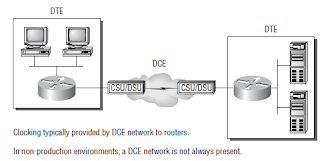By default, router interfaces are data terminal equipment (DTE), and they connect into data communication equipment (DCE) like a channel service unit/data service unit (CSU/DSU).
The CSU/DSU then plugs into a demarcation location (demarc) and is the service provider’s last responsibility. Most of the time, the demarc is a jack that has an RJ-45 (8-pin modular) female connector located in a telecommunications closet. Actually, you may already have heard of demarcs.
If you’ve ever had the glorious experience of reporting a problem to your service provider, they’ll usually tell you everything tests out fine up to the demarc, so the problem must be the CPE, or customer premises equipment. In other words, it’s your problem not theirs.
Figure 1 shows a typical DTE-DCE-DTE connection and the devices used in the network. The idea behind a WAN is to be able to connect two DTE networks through a DCE network. The DCE network includes the CSU/DSU, through the provider’s wiring and switches, all the way to the CSU/DSU at the other end.
The network’s DCE device (CSU/DSU) provides clocking to the DTE-connected interface (the router’s serial interface). As mentioned, the DCE network provides clocking to the router; this is the CSU/DSU.
If you have a nonproduction network and you’re using a WAN crossover type of cable and do not have a CSU/DSU, then you need to provide clocking on the DCE end of the cable by using the clock rate command.
The CSU/DSU then plugs into a demarcation location (demarc) and is the service provider’s last responsibility. Most of the time, the demarc is a jack that has an RJ-45 (8-pin modular) female connector located in a telecommunications closet. Actually, you may already have heard of demarcs.
If you’ve ever had the glorious experience of reporting a problem to your service provider, they’ll usually tell you everything tests out fine up to the demarc, so the problem must be the CPE, or customer premises equipment. In other words, it’s your problem not theirs.
Figure 1 shows a typical DTE-DCE-DTE connection and the devices used in the network. The idea behind a WAN is to be able to connect two DTE networks through a DCE network. The DCE network includes the CSU/DSU, through the provider’s wiring and switches, all the way to the CSU/DSU at the other end.
The network’s DCE device (CSU/DSU) provides clocking to the DTE-connected interface (the router’s serial interface). As mentioned, the DCE network provides clocking to the router; this is the CSU/DSU.
If you have a nonproduction network and you’re using a WAN crossover type of cable and do not have a CSU/DSU, then you need to provide clocking on the DCE end of the cable by using the clock rate command.

No comments:
Post a Comment